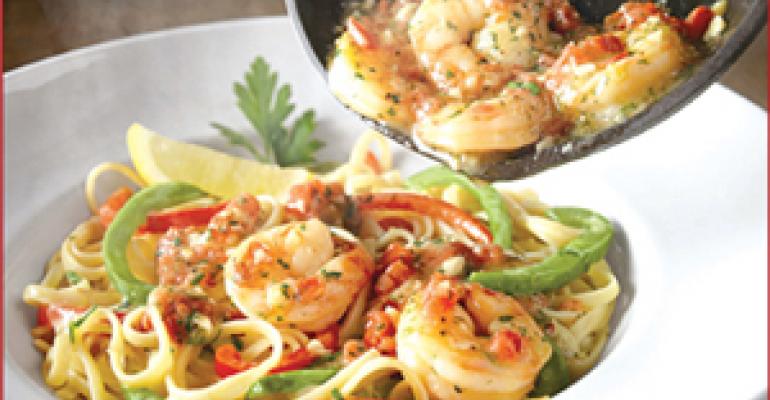On Tuesdays at the fine-dining Whist restaurant at the Viceroy Hotel in Santa Monica, Calif., executive chef Warren Schwartz gets to bust out of the kitchen.
That’s the night when Schwartz cooks out by the hotel pool over a large barbecue grill. Guests mill about around him as he prepares small plates for $5 each. He often experiments with whatever is fresh and in season: grilled lobster tail with arugula, sweet corn and roasted-pepper butter; elk with foie gras-cherry butter; or bacon-wrapped scallops with fennel and aïoli. Nearby a DJ spins tunes, and the mood is festive and relaxed.
Servers also walk the poolside dining area with trays, offering the dishes to diners at tables, but Schwartz’s goal is to draw his guests around the grill for a taste and conversation.
“It removes all the boundaries of the kitchen and the dining room table,” he says. “I want people to interact, to talk about where the food comes from.”
Schwartz is one of a number of chefs looking for more face time with their audience. No longer content to perform magic in closed-off kitchens, these chefs are social creatures seeking new ways to interact with diners.
At Pizzeria Mozza in Los Angeles, for example, chef-owner Nancy Silverton expedites her wood-fired pizzas as guests sit around a counter that surrounds the pizza station. In her adjacent restaurant, Osteria Mozza, scheduled to open this month, Silverton will work her mozzarella bar, a counter area with seating where she will prepare her cheese-centric antipasto dishes while chatting up guests.
Nearby on Melrose Avenue, at the recently opened restaurant The Foundry, executive chef Eric Greenspan expedites dishes from the dining room, which allows diners an even more intimate view of culinary operations than are afforded by a typical exhibition kitchen. Here, it’s more like a “Hell’s Kitchen”-style dinner theater, with Greenspan at the center of the action.
Theatrical, tableside cooking has long been a feature of chains such as El Torito and El Torito Grill, owned by Cypress, Calif.-based Real Mex Restaurants. Their guacamole is mixed at the table. Similarly, Miami-based Benihana pioneered teppanyaki dining, and Los Angeles-based Lawry’s The Prime Rib has long been known for carving its beef tableside.
But now restaurants at all levels feature new takes on such customer-friendly presentations.
Romano’s Macaroni Grill, a division of Dallas-based Brinker International, for example, recently rolled out two new linguine dishes whose toppings of Sizzling Shrimp Scampi or Sizzling Tuscan Chicken in garlic-white wine sauces are poured out of hot sauté pans by servers at the table. Prices start at $10.99 for the chicken and $12.99 for the shrimp and vary throughout the country.
At the new, upscale-casual Ketchup grill concept in West Hollywood, Calif., which was opened in April by Los Angeles-based The Dolce Group, the bartender gets to be the tableside star.
After guests at Ketchup are seated, a roving drink cart rolls up with the offer of a full line of exotic cocktails, each for $12. Guests can sample miniature shots of the “American Psycho,” a blend of vanilla vodka, chocolate drink and coffee liquor, or an “Ooh Yeah,” made from citrus vodka and fruit punch, before they buy. All drinks are prepared tableside.
“All of our servers are also trained to encourage family-style dining,” says Lonnie Moore, a Dolce Group partner, “and servers will make everyone a plate at the table, dividing up the chopped salad or an order of scallops, if people want.”
The fine-dining Willard Room restaurant at the historic Willard InterContinental Hotel in downtown Washington, D.C., also has been adding more dishes with tableside presentation over the past year.
It began with a classic Caesar salad for two, $11, for which servers tossed in Spanish white anchovies, garlic croutons and shaved Parmigiano-Reggiano to order.
The dish was so popular that chef de cuisine Nicolas Legret and general manager William Washington have trained the staff to execute a line of new tableside presentations, from the house-smoked organic salmon—which is sliced at the table and served with warm buckwheat blinis and chopped egg, caper and parsley garnishes—to bananas Foster and cherries jubilee that are flam-béed tableside for dessert.
“Customers love it,” says Legret, a Frenchman who cooked previously at the Hôtel de Crillon in Paris. “It’s really the old French service, but here, no one is doing it.”
One dish that is particularly popular is a salt-crusted chicken, $30, which comes to the table still in its “shell.” The server breaks the shell and carefully slices the succulent chicken inside. The breast is plated with a roasted and braised chicken leg on the bone along with mashed potatoes, wild mushrooms and asparagus. Roasted veal kidneys also are carved tableside on rolling carts, and several fish dishes are filleted and plated at the table as guests look on. Still, Legret is reluctant to come out of the dining room.
“If I start doing that,” he says, “then the next table will say, ‘Why do they get to talk to the chef?’ and they might feel hurt. I prefer to stay in the kitchen.”
Interaction with guests isn’t for all chefs. It depends on their personalities, Schwartz says. At Whist, the weekly “Taste of Tuesdays” event was born out of a need to draw in diners on a slow night, but also to attract younger guests to more serious dining in a more accessible way.
Schwartz says he was a bit bored by the notion that fine dining was all about developing the next even-more-complex dish or sourcing more expensive tableware. Grilling by the pool allows him to introduce sophisticated tastes to customers who might be intimidated by such aspects of fine dining.
He hopes the guests who love the dishes they taste around the poolside grill will come back to see what he can do inside.
“In this competitive climate, you have to be out there,” he says. “You can’t just hide in the kitchen and expect them to come to you.”




